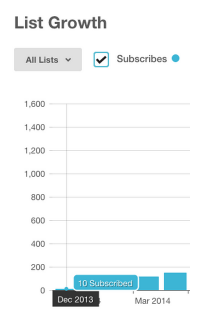
Poornima Vijayashanker is the founder of Femgineer, helping entrepreneurs and tech professionals (especially women) level up their careers.
“Why is email the most effective channel for converting customers?”
Exactly a year ago I had 10 people subscribe to my email list each month. I let out a big sigh and thought, “How am I going to go from 10 to 10K?”
It seemed pretty daunting, and I thought, “Why bother? Who even reads emails?”
You’re probably thinking the same thing.
Each one of us suffers from inbox clutter, including you. Consider all the personal, business, and commercial messages you need to wade through on a daily or even hourly basis.
How on earth are you supposed to break through that inbox noise to sell someone a product or service?
The truth is, people do read emails. Don’t you? Even though you get a lot of emails, you probably still feel obligated to go through them to make sure you’re not missing some important communication, especially if it’s from someone you were expecting to hear from.
FOMO (the fear of missing out) is why email is such a draw, and subsequently becomes an effective marketing channel!
When a person gives you their email address by, for example, signing up for your newsletter, they have given you an invitation to your inbox. There’s no other communication medium that lets you get so close to a person’s inner world without being intrusive or inconvenient.
Think about it: when you call someone, you might catch them at a bad time. If you show up unannounced, there’s also an issue with timing. But with email, if they have subscribed, then they’ve indicated that they are waiting to hear from you.
 For these reasons, email is the most targeted communication channel, and companies realize it: nearly $2.1B is spent on email marketing annually.
For these reasons, email is the most targeted communication channel, and companies realize it: nearly $2.1B is spent on email marketing annually.
Email marketing budgets are spent on content creation and testing the message components. Everything matters in an email: delivery time, subject, sender, and the message contained within it. However, people gloss over these details, get poor results, and conclude that email is ineffective.
With attention to detail and worthwhile content, you can turn your emails into powerful conversion tools. But before pouring your heart into content and wrestling with subject lines, you need to build your email list.
So how do you compel people to give you their email addresses?
There are a number of techniques, but my personal go-to method is writing compelling blog posts, or as Nathan Barry calls them, epic blog posts. An epic blog post isn’t just lengthy for the sake of being lengthy. It does the following:
- Draws the reader’s attention with a clear title. Here’s an example from Nathan: The Complete Guide to Making a Full-Time Salary From One Book. It’s not click bait; it’s clear.
- Highlights a problem that will resonate with the reader.
- Provides a step-by-step solution to solving the problem. This how-to can be replicated by the reader.
When you write an epic blog post a couple things happen:
- The reader gains knowledge.
- The author gains credibility.
That exchange makes it easier to do a small ASK at the end of the post, which is a CTA (call-to-action)—for example, “sign up to receive more posts like this.”
The key next step is to promote each epic blog post across additional channels, such as Medium, other people’s blogs (as a guest blog post), and social media, like Twitter and Facebook.
Using the epic blog post technique, I went from 10 people subscribing to my email list organically each month to hundreds a month.
Starting sending emails!
Once you’ve got a person’s email address, you’ve got permission to start sending them messages. If you’re just starting out, don’t think your list is too small to begin. Instead, realize that people gave you their addresses and are waiting to hear from you!
The sooner you start sending out valuable information and the more frequently you do it, the more likely someone is to forward your info to another potential customer (and you’ll benefit from word-of-mouth marketing).
When I say this, I know people get really nervous and are afraid that if they send out emails frequently, they’ll be perceived as spammy.
But remember: they subscribed because you offered them value through your initial epic blog post. To keep them subscribed, you need to continue to offer value.
If people really don’t find your emails useful or valuable they can unsubscribe at any time. Let them! It’s a clear signal that they really weren’t interested. However, if you’re doing a good job of continuing to add value, they will be interested, want to hear from you, and stay subscribed.
Types of email to send out
Here are the types of email campaigns to keep your customers engaged and even purchasing your products and services:
Drip campaign
The goal of a drip campaign is to periodically send out valuable information. Valuable information does not mean a sales pitch! It means helpful guidance and insights like how to use your product, how to get in touch with your company for customer support, or solutions to problems that customers might be experiencing.
You want to keep the time interval consistent, because the point of a drip campaign is to set the expectation that they will receive information from you daily, weekly, or monthly.
For example, you might have an onboarding drip campaign that is seven days long, and each day the customer receives an email that explains how to use different features within your product. After that, you might switch them to a weekly drip campaign in which they receive an email from you each week that shares your expertise on the types of problems they are experiencing.
You can also do a drip campaign leading up to the launch of your product or an event that you’re hosting.
The goals of a drip campaign are to add value to customers’ lives and use that contribution to keep people engaged and stay top-of-mind (i.e., relevant).
Relevancy is all about frequency. If you send emails sporadically people are more likely to forget about you, your product, and your company. They’re also more likely to unsubscribe.
Newsletter
This type of email will contain general information about product and company updates, and can be sent out monthly or quarterly.
Too often, people jam-pack newsletters with a lot of information and too many CTAs. If you find yourself putting sales or product info into a newsletter, then move that info into either a drip or sales campaign.
Lifecycle campaigns
These are campaigns you send out to pull customers back into your product, and they are triggered based off of customers’ actions (or inaction).
The goal of these campaigns is to increase engagement with your customers and stay top-of-mind. To set a campaign up like this, you’d need to use a tool like Mixpanel.
Sales campaign
You’re really only going to send out sales campaigns when you’re running a promotion or sale.
What you don’t want to do is wait until the day of a sale to send out its promotion email. Why? Because people need to be primed! What if they are on vacation and miss out on your sale?
To avoid that situation, send out a series of emails—just one per week is good enough—to prime them. Send out a final email with a CTA encouraging them to purchase on the day of the sale, and let them know that this is the last email reminder.
Don’t be afraid of sending out sales emails alongside other types of emails. It’s actually a great strategy because you’re adding value and then making a small ask.
When I ran a sales email campaign for my new book, How to Transform Your Ideas into Software Products, I started priming customers a month in advance. Each week I’d send an email about why I wrote the book, another about what was in it, and one about how it would benefit them.
The day before the launch I sent over details about the various packages they could purchase, then on the day of the sale I sent a link to the landing page. I proceeded to send two more emails the two days following the sale.
The results were incredible. I saw sales come in about an hour after each email—sometimes even within minutes!
Measure, then measure more
The success of an email campaign depends on a delicate balance between the value you provide and the calls-to-action that drive your business forward. Therefore, you’ll have to manage the ratio of value-add to ask. I’m not going to sit here and tell you its 80/20. You’ve gotta test it out.
Track open rates of each email and measure how many times a reader acted on your CTA. And, keep track of your unsubscribe rate from the start; it will signal a person’s fit or disinterest.
Do you have a favorite trick to get more people on your email list or create content they love? Let us know in the comments below.
Read next: The anatomy of a marketing email that drives results
Get the TNW newsletter
Get the most important tech news in your inbox each week.








